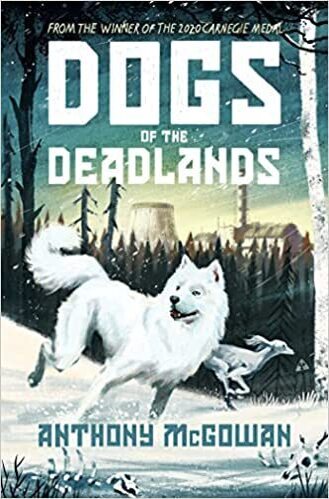4/5
Author: Anthony McGowan
Publisher: Rock the Boat
Genres: middle school/young adult, historical fiction, adventure, animals
A tale of courage, companionship, and hope… Chernobyl, 1986. The world is coming to an end. Dragged from her bed in the middle of the night, Natasha is forced to leave her beloved puppy behind and has no idea if she’ll ever return home. Growing up in the shadow of the ruined nuclear power plant, pups Misha and Bratan need to learn how to live wild—and fast. Creatures with sharp teeth, claws and yellow eyes lurk in the overgrown woods. And they’re watching the brothers… But will the dogs survive without the humans? And can the humans live without them?
As humans fled the nuclear disaster, they were forced to leave their pets behind. Without people, nature began to return to the woods surrounding the power plant—lynx, bear and wolves. But the overgrown forest is no place for dogs. Can Zoya, and her pups Misha and Luka, learn to survive in the deadlands? And will Zoya ever find her way home to her beloved owner?
It has been a good while since I’ve been on an animal adventure like this one. Indeed, the comparisons to Watership Down are fair, though this certainly has its own flavor. Where some animal adventures toe the line of fantasy, with its characters speaking or having lore and anthropomorphized culture, this one feels urgent, wild and real. The adventures and journeys of these dogs are as fierce, cold and terrifying as the backdrop itself. There were multiple times I had to gasp aloud, reading later into the night to finish a no-holds-barred fight. In between are welcome moments of peace, rest and thankfully, love.
This book’s strengths come in the tales of camaraderie and survival among the dogs and wolves, culminating regularly in small skirmishes and epic standoffs. The author doesn’t shy away from harm befalling his characters, so we’re always on the edge of our seat waiting to see if our favorite dogs will make it through this literal dog-eat-dog world.
Another strength is its setting; I read this in the summer in the US Midwest, but certainly you can feel the cold USSR (note: Chernobyl is in modern Ukraine) and its forests, including the area around Chernobyl, whose wildlife have had to adapt to more than just predators. There are also multiple coming-of-age stories within the main thread, done fairly well, especially as the dogs are concerned. Another strength is the sheer ambition of writing such a story, and the amount of research that likely went into both the area and the nature of dogs and wolves (and other wildlife). I feel like I know a lot more about my own dog after reading about Misha and the others!
Where this book struggles a little bit is in executing its grand ambitions and how the final product compares to what a reader might expect. For example, in a book whose plot depends on the Chernobyl disaster, I had hoped that that event would have entered the story more often. With the exception of the opening scene that causes the separation, the “deadlands” really only enter the story occasionally, with their quiet stillness and off-color vegetation occasionally unsettling the dogs or wolves, or the implied poisoning of certain prey animals—but they never really know why. It may have been better, and perhaps clearer, if a little more detail had been given to the spoiling of the land that this story takes place on, instead of just being an unseen and mostly un-acting backdrop to what we assume is a normal feral-dog-vs-wolves survival story. Perhaps it can inspire younger readers to read more about Chernobyl once they’ve finished.
The second challenge this book faces is in its weaving of its characters’ stories. To be realistic, the author tells several different dog stories (since dogs don’t live as long as humans), and then weaves in one brief human story while putting the primary human mostly on hiatus. Natasha plays a much smaller role than I expected at the beginning, and by the time her adult story is really told, the main action and arcs of the dogs are mostly finished, so it feels like an afterthought, thrown in for denouement.
While the end is ultimately satisfying, there are multiple ends throughout the book, which keeps you guessing exactly how the author wants this to wrap up. This is a strength for some, but could be considered disjointed or incomplete for others. The author mentions War and Peace as an inspiration, and having read that tome this year, I can say that that’s not for everyone: It’s a very difficult task to weave so many arcs together and still satisfy your (young) readers. The dogs’ arcs are compelling, but the humans’ feel rushed, despite the difference in lifespan.
I am considering using this as a read-aloud for my middle-grade kids, and certainly it’s a great candidate for boys and girls who love adventure! Like Watership Down, young readers may be shocked to read the realistic descriptions of the fights and their aftermath, and so it could be triggering to younger readers (or listeners) who have pet dogs, in case they fear them escaping and suffering violence, or picture them doing violence. Our dog is a fairly jumpy and reactive dog, so I don’t want them worrying about her becoming feral and running off into the wild. I think the ends of the stories, especially as humans enter them, can help bring that connection back to a safe place.
Don’t get me wrong: these caveats only bring my rating “down” to four stars!
Ultimately, it’s quite an adventure story and unique when it comes to dog stories. I salute McGowan’s efforts to create an exciting, realistic and heartfelt story that keeps the reader guessing and gasping! I would certainly recommend for ages ten and up, with some content advisory involving (natural but graphic) violence among animals. It certainly earns its place among the more engrossing animal adventures.
– Jon Gill
Note from Jon: While this book begins in 1986 USSR, it continues into modern day Ukraine. Releasing this book now may be a good opportunity for the author, publishers and readers to donate to relief efforts in Ukraine as they fight for their existence.


